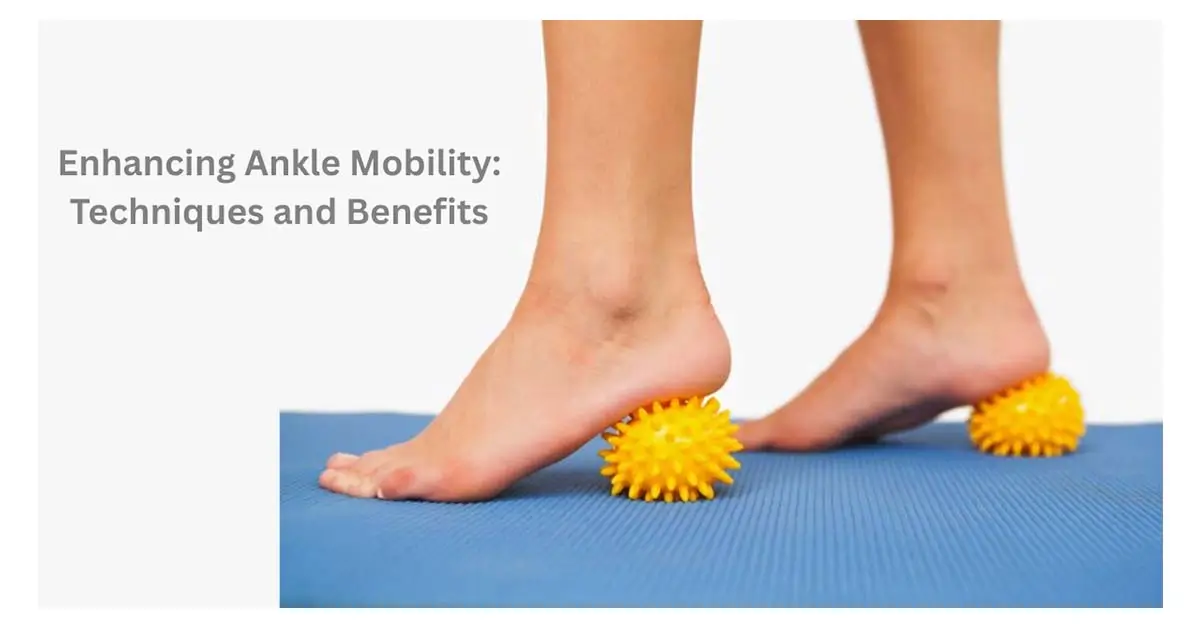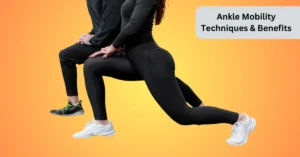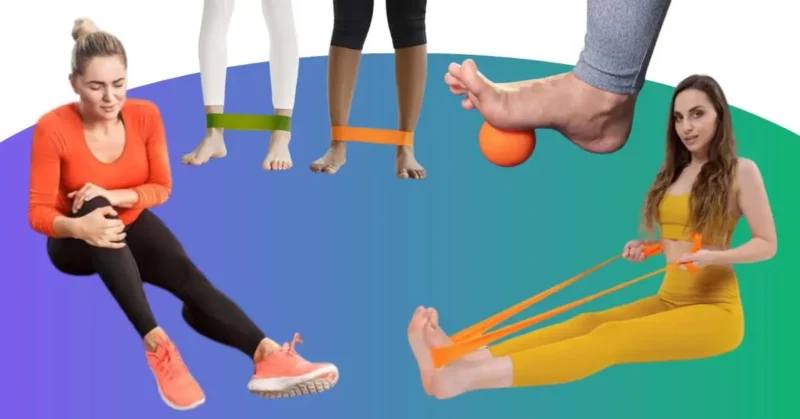Learn how improving ankle mobility enhances flexibility, reduces knee and hip stress, and boosts overall movement efficiency with key exercises and tips.
Thank you for reading this post, don't forget to subscribe!Ankle mobility is essential for athletes and anyone looking to improve their overall movement and prevent injuries. Whether you’re a runner, weightlifter, or simply trying to stay active, having flexible and stable ankles will enhance performance and protect your joints. This comprehensive guide will explore practical ways to improve ankle mobility, its benefits, and how it impacts your entire body.
Why Ankle Mobility Matters for Health and Performance
Ankle mobility refers to the range of motion (ROM) in your ankle joint, which affects walking, running, jumping, and squatting. Poor ankle mobility can lead to compensation patterns in your body, causing knee, hip, or lower back pain. It can also increase the risk of injuries like sprained ankles or Achilles tendonitis.
Key Benefits of Ankle Mobility
- Improved Performance: An excellent range of motion leads to better movement efficiency.
- Injury Prevention: Strong, flexible ankles help absorb shocks and prevent ankle sprains.
- Better Posture and Stability: Well-functioning ankles support the alignment of your knees and hips.
Assessing Your Ankle Mobility
Assessing your current range of motion before working on your ankle mobility is essential. One of the simplest ways is the Knee-to-Wall Test:
Knee-to-Wall Test
- Stand facing a wall with one foot about five inches away.
- Bend your knee forward, aiming to touch the wall while keeping your heel on the ground.
- Measure how far you can reach without lifting your heel.
- Repeat on the other side.
If you struggle to get your knee close to the wall, you may have limited ankle dorsiflexion, which needs attention.
Practical Exercises for Ankle Mobility
Below are some proven techniques for improving ankle flexibility and strength. Consistently performing these exercises will boost your overall ankle health. Proper ankle mobility helps prevent injury and enhances performance in activities such as running, squatting, and jumping.
Ankle Circles
How to Perform:
- Sit on the ground with one leg extended in front of you.
- Slowly rotate your ankle in large, controlled circles.
- Move your ankle clockwise for ten rotations, then counterclockwise for another 10.
- Switch to the other foot and repeat.
Benefits:
- It enhances the range of motion by stretching the muscles, tendons, and ligaments around the ankle.
- It loosens tight muscles and promotes better circulation to the foot and ankle, which can help reduce stiffness.
- It improves proprioception (your body’s awareness of movement and balance), crucial for preventing injuries.
Calf Stretch
How to Perform:
- Stand facing a wall, and place both hands on the wall at shoulder height.
- Extend one leg behind you while pressing the back heel firmly into the floor.
- Push your hips forward to stretch the calf muscles of the extended leg.
- Hold the stretch for 20-30 seconds, then switch legs and repeat.
Benefits:
- It targets the gastrocnemius and soleus muscles, two critical muscles in the calf that directly affect ankle flexibility.
- It helps to increase dorsiflexion (the ability to flex your foot upward), which is essential for running, jumping, and squatting.
- It improves overall lower leg mobility and reduces the risk of conditions like Achilles tendonitis and shin splints.
Banded Ankle Distraction
How to Perform:
- Attach a resistance band securely to a low, sturdy object (like a pole or heavy furniture).
- Place the loop of the band around your ankle, just above the joint.
- Step back to create tension in the band while keeping your foot flat.
- Lean forward to stretch the ankle joint, allowing the band to pull gently on the joint.
- Hold for 15-20 seconds, perform 2-3 sets on each leg.
Benefits:
- It enhances joint space by applying distraction (pulling) forces to the ankle, improving mobility within the joint capsule.
- It helps break up adhesions (tight, sticky areas) around the joint, increasing flexibility.
- It benefits individuals with restricted ankle dorsiflexion, helping to improve deep squats and other movements requiring full ankle mobility.
Toe Raises
How to Perform:
- Stand with your feet shoulder-width apart.
- Raise your heels off the ground, balancing on the balls of your feet.
- Hold the position for 2-3 seconds before slowly lowering your heels back to the ground.
- Perform three sets of 10–12 repetitions.
Benefits:
- It strengthens the muscles surrounding the ankle, especially the calf muscles.
- It improves ankle stability, which is crucial for balance and proper posture during dynamic movements.
- It’s regular practice helps reinforce better balance and foot control, reducing the risk of ankle sprains.
Squat to Stand
How to Perform:
- Begin in a deep squat position with your feet shoulder-width apart and flat on the floor.
- Slowly straighten your legs to stand up, keeping your heels firmly planted.
- Once fully standing, drop back into the deep squat and repeat the motion.
- Perform 8–10 repetitions in a controlled manner.
Benefits:
- It mobilizes the ankle joint by promoting deep dorsiflexion as you move in and out of the squat position.
- It enhances hip and lower back flexibility, improving your overall mobility.
- This exercise mimics natural, functional movements, helping to improve body mechanics during activities like walking, lifting, and running.
Incorporating Ankle Mobility into Your Routine
To maximize the benefits of these exercises, you must include ankle mobility work in your regular fitness routine. Whether you’re an athlete or runner or want to improve overall flexibility, ankle mobility drills should be part of your warm-up and recovery sessions.
Suggested Routine
Warm-up:
- Start with 5-10 minutes of light cardio, such as jumping jacks, brisk walking, or cycling, to get your blood flowing.
Ankle Mobility Exercises:
- Spend 10-15 minutes on targeted stretches and mobility drills, such as ankle circles, calf stretches, and banded ankle distraction.
Strengthening:
- Finish with strengthening exercises like toe raises and squat-to-stand to reinforce stability and control in the ankle joint.
By consistently performing these exercises, you’ll increase ankle strength and flexibility, reduce the risk of injuries, and enhance overall athletic performance.
Weekly Schedule for Ankle Mobility
Day Focus Area Time (minutes)
- Monday: Mobility Drills 10-15
- Wednesday: Strengthening + Stretch 20
- Friday: Balance + Stability 15-20
- Sunday: Recovery Stretching 10
Ankle Mobility and Its Connection to Knee and Hip Health
Improving ankle mobility can significantly impact other joints’ overall function and health, particularly the knees and hips. Tight or restricted ankle movement can lead to compensations in how the body performs various functional movements, such as squats and lunges. When your ankles are stiff, the limited range of motion forces the knees and hips to take on more stress to achieve the movement, leading to overuse injuries, pain, or improper alignment.
The Importance of Ankle Dorsiflexion and Plantarflexion
- Dorsiflexion (upward movement of the foot) is crucial for exercises like squats and lunges, where the ability to flex your ankle allows you to descend deeply and maintain proper form. Limited dorsiflexion often causes individuals to lift their heels or shift their weight forward, placing excessive pressure on the knees. Over time, this can contribute to knee pain or injury.
- Plantarflexion (downward movement of the foot) is equally essential, especially in running or jumping, where you need to push off the ground efficiently. Poor plantarflexion can restrict your power output and lead to strain on the Achilles tendon or calf muscles.
Improving dorsiflexion and plantarflexion creates a better foundation for functional movements, promoting proper alignment of the knees and hips, and reducing the risk of compensatory injuries in the lower body.
How Improved Ankle Mobility Enhances Overall Movement
When your ankles move freely, your body is better equipped to handle various activities: walking, running, jumping, or weightlifting. A mobile ankle allows for:
- Proper Knee Alignment: With increased dorsiflexion, the knees can track over the toes more naturally, reducing stress on the knee joint during movements like squats, lunges, and step-ups.
- Better Hip Mechanics: Mobile ankles relieve pressure on the hips, allowing them to move in sync with the lower leg. This reduces the risk of hip pain or imbalances that might arise from restricted ankle motion.
- Improved Posture: Restricted ankle movement often forces the body to compensate with poor posture, leading to muscle imbalances and joint misalignment. Greater ankle mobility supports better posture during dynamic and static movements, contributing to a more efficient overall movement pattern.
Common Mistakes to Avoid in Ankle Mobility Training
While ankle mobility exercises are highly beneficial, improper techniques or approaches can hinder progress and even lead to injury. Avoid these common mistakes to ensure you’re getting the most out of your training:
- Forcing Stretches: One of the most common mistakes is pushing your ankle too hard during stretching exercises. Overstretching can lead to ligament damage or muscle strain, slowing progress. Focus on gentle, controlled movements that allow the ankle joint to loosen up gradually. Stretching should never cause pain, only mild discomfort.
- Ignoring Stability: While improving flexibility is crucial, developing stability around the ankle joint is equally essential. Increased mobility may leave your ankle vulnerable to sprains or other injuries without stability. Incorporate exercises that challenge your balance, such as single-leg stands or dynamic movements like walking lunges, to strengthen the muscles that stabilize the ankle.
- Neglecting Consistency: Mobility improvements don’t happen overnight. To see lasting results, it’s essential to perform ankle mobility exercises consistently. Skipping sessions or only working on mobility sporadically will slow down your progress. Aim to regularly include mobility work in your warm-ups or cool-downs, especially if you frequently engage in lower-body exercises like squats or running.
By addressing these common mistakes, you can ensure that your ankle mobility training is safe and effective. It will improve performance and reduce injury risk throughout your lower body. Consistent ankle mobility work will promote healthier, more efficient movement patterns and allow you to move more freely and comfortably in your daily activities.
FAQs on Ankle Mobility
Q. What are the benefits of ankle mobility exercises?
Ankle mobility exercises offer a range of benefits, including an improved range of motion in the ankle joint, which enhances movement efficiency and overall performance. These exercises help prevent common injuries such as ankle sprains, Achilles tendonitis, and shin splints. They also promote better posture, balance, and alignment by allowing proper mechanics in activities like running, squatting, and jumping. Regular ankle mobility helps reduce compensatory movement patterns, which can otherwise lead to pain and injuries in the knees, hips, or lower back.
Q. What are the benefits of ankle rotations?
Ankle rotations help loosen and mobilize the muscles, tendons, and ligaments around the ankle joint. They also improve circulation, enhance flexibility, and increase the ankle’s range of motion. Regularly performing ankle rotations can help prevent stiffness and tightness, which are common in sedentary individuals or those recovering from ankle injuries. This exercise also improves proprioception, helping to maintain balance and coordination during physical activities.
Q. What are the benefits of keeping the ankle joint mobile?
Keeping the ankle joint mobile helps to maintain flexibility and prevent joint stiffness, which is crucial for walking, running, and other activities that involve lower body movement. A mobile ankle joint allows for better shock absorption during dynamic activities, reducing the risk of injury. It also ensures proper alignment and weight distribution, contributing to overall joint health, especially in the knees and hips. Consistent ankle mobility can support better functional movement and reduce the likelihood of long-term joint issues.
Q. What are the benefits of foot and ankle exercises?
Foot and ankle exercises strengthen the muscles that support the foot and ankle, improving stability and reducing the risk of injuries like sprains and fractures. These exercises enhance balance, coordination, and proprioception, which are vital for athletes and active individuals. Strengthening the foot and ankle can also correct posture and gait imbalances, leading to better movement patterns. Additionally, these exercises help manage and prevent conditions such as plantar fasciitis and flat feet by increasing flexibility and strength in the foot arch.
Q. What are the benefits of foot mobility?
Foot mobility ensures that the numerous bones, joints, and muscles in the foot move freely and efficiently. Improved foot mobility improves shock absorption, reducing strain on the knees, hips, and spine. It also enhances balance and stability during activities that require complex movement patterns, such as running or hiking. Improved foot mobility makes you less likely to experience common foot-related issues like plantar fasciitis or arch pain. Maintaining foot mobility can lead to smoother, more efficient movement in all physical activities.
Q. What are the benefits of active ankle movements?
Active ankle movements, such as dorsiflexion (pulling the toes up) and plantarflexion (pointing the toes), strengthen the muscles around the ankle joint while enhancing flexibility and range of motion. These movements help improve circulation, maintain joint health, and prevent stiffness. They are also beneficial for improving balance, coordination, and stability, and are essential for dynamic sports and daily activities. Regular practice also reduces the risk of ankle sprains and other injuries by keeping the joint strong and flexible.
Conclusion on Ankle Mobility
Ankle mobility is a crucial component of physical health that is sometimes disregarded yet significantly impacts general well-being. Spending time strengthening and increasing flexibility in this area will help you perform better, avoid injuries, and maintain healthy joint function throughout your lower body.
Consistently improving ankle mobility can help you maintain an active lifestyle and improve the health of your hips and knees. By following these exercises and techniques, you can build a strong base of flexibility to enhance your long-term health and performance.
Read more articles on optimal health.
You might like to read:
How Frequently Should You Perform Hip Mobility Exercises for Better Movement?



